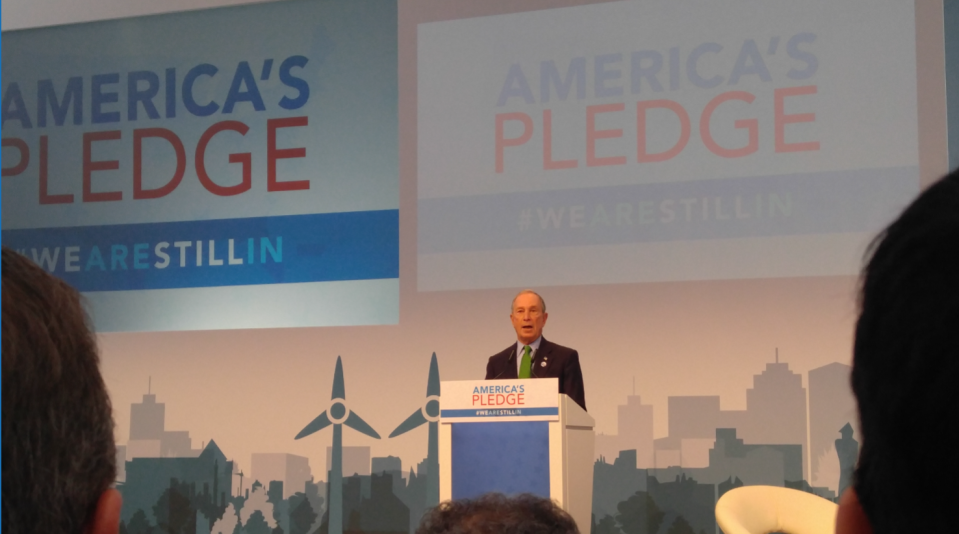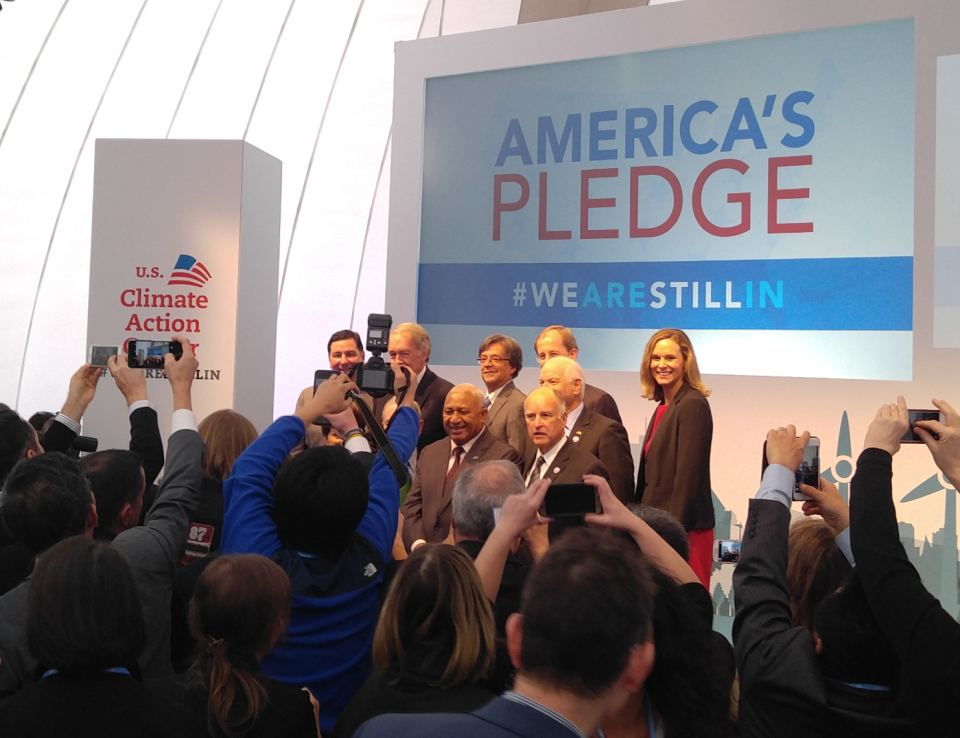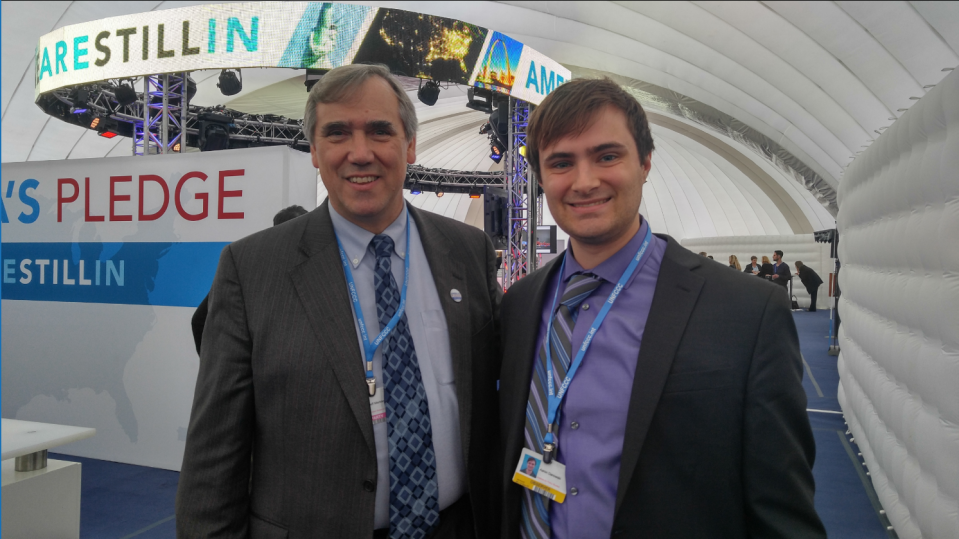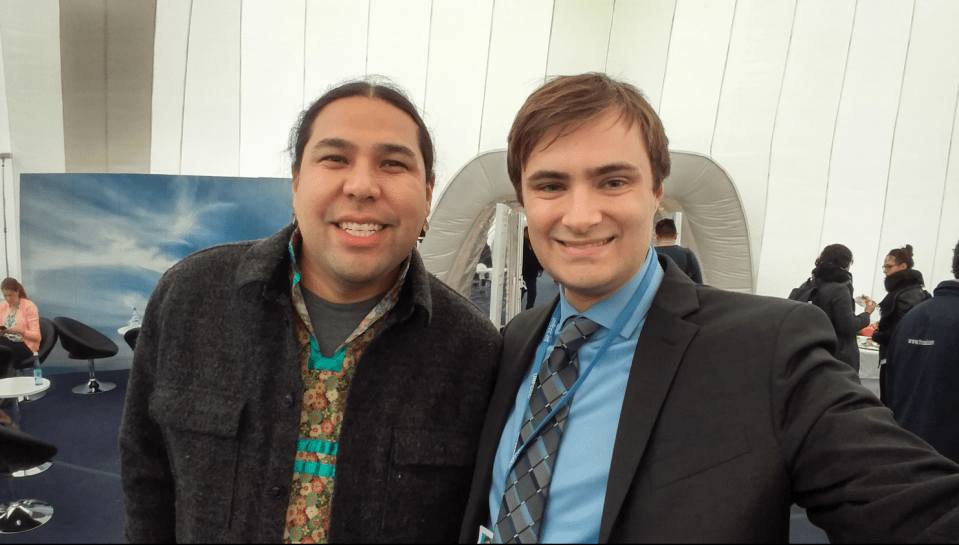Former New York City Mayor Michael Bloomberg and California Governor Jerry Brown were here in Bonn on Saturday to kick off “America’s Pledge,” a joint effort by American states, cities, businesses, and non-state actors to continue to abide by the Paris Agreement in spite of Donald Trump’s opposition to it.

Former Mayor Michael Bloomberg introducing America’s Pledge
Ask just about anyone here at the conference and they’ll tell you that American climate policy is dictated more by local actors than by Donald Trump, and “America’s Pledge” is a good example of that. The reach and scope of the pledge is impressive. The 2500+ cities, states, businesses and other signatories represent a total of 159 million Americans, $10.1 trillion in Gross Domestic Product, and 2.3 Gigatons of emissions (35 percent of the countrys total).
The kick-off event was held at the U.S. Climate Action Center, a complex funded by Bloomberg Philanthropies and the Hewlett Foundation to serve as an unofficial US pavilion for local climate actors to display their climate initiatives to the world
The launch of “America’s Pledge” was the marquee event to be held at the Center, with the President of COP 23 Frank Bainimarama and UNFCCC Executive Secretary Patricia Espinoza in attendance.

COP 23 President Frank Bainimarama and California Governor Jerry Brown (front right) standing for a photo after the “America’s Pledge” kick-off event with other panelists.
The event did not, however, go according to plan. About midway through the program, right as California Governor Jerry Brown took the stage to tout California’s climate leadership, members of the Indigenous Environmental Network planted in the audience stood up and started asking him what that really meant. They called California’s cap-and-trade system “a false solution to climate change” and criticizing the expansion of dirty oil and gas extraction in the state under the Governor’s leadership. They criticized the handling of the Aliso Canyon methane leak and the continued practice of fracking across the state. As the protesters called for Governor Brown to “Keep it In the Ground,” he lashed out aggressively, shouting “I agree with you, [let’s keep it] in the ground. Let’s put YOU in the ground so we can get on with the show here.” A member of California’s assembly, flanked by a representative from the International Emissions Trading Association, started to chant “We’re still in! We’re still in!” in Brown’s defense and was quickly joined by the rest of the crowd, their voices drowning out the protesters as they were escorted out by security. You can watch part of the protest here and here.
This scene captured the tension I had felt growing all week, and now it was at the boiling point. The moment when “market-based” and “social-movement-based” approaches to climate action collided head on, splitting along fault lines of irreconcilable difference over whether to prioritize economics or justice.
As the last of the protesters were escorted out by security, Governor Brown turned back towards the crowd and uttered the phrase “I think to get the job done we’re going to need a little more intellectual content than just repeating slogans.” The distain in his voice was evident. “Unfortunately in politics, we don’t have a magic wand. I don’t wake up in the morning and say ‘Stop, there’s no more oil, there’s no more coal.’ No! It takes a plan. Otherwise all you get is noise – and that is really good noise! But it doesn’t get the job done….” As thunderous applause broke out, he concluded: “California‘s climate policy is the most aggressive, the most far reaching in the country, in the Western Hemisphere!… We’re here, we’re in, and we’re not going away!”

While I understand that there are political realities that limit what types of climate policies are feasible for people like Governor Brown to implement, I agree strongly with the protesters claiming he could be doing more. He has rejected efforts to impose a moratorium on fracking in the state, for instance. California’s cap-and-trade system allows polluters like Chevron and Shell to avoid paying for their emissions by issuing free allowances and allows for the purchase of dubious carbon offsets instead of reducing emissions at their source (thanks in large part to millions in corporate lobbying efforts during the drafting of the legislation). For a quick primer on the problems with cap-and-trade, check out Annie Leonard’s video below:
Serious climate action can only occur when oil and gas companies are acknowledged to be rogue entities that stand in the way of climate action, not stakeholders to be bargained with. In the words of Bill McKibben, “They’re outlaws… not outlaws against the laws of the state, they get to write those for the most part. But they’re outlaws against the laws of physics. If they carry out their business plan, the planet tanks,” as 350.org explains in their excellent mini-documentary “Do the Math”:
Once we realize we don’t need to play by the oil industry’s rules, real climate solutions begin to emerge. The political environment will change drastically when oil companies if and when companies like Exxon, Tesoro, and Phillips 66 aren’t allowed to funnel hundreds of millions of dollars into political campaigns and use lobbyists to protect their interests anymore. We would be able to ban fracking, prevent conflicts like Standing Rock by ceasing to construct new pipelines, and achieve a just transition to a clean energy economy through what Pittsburg Mayor Bill Peduto calls an “American Marshall Plan.” We could train professionals to work in well-paying renewable energy jobs in formerly fossil-fuel dependent areas such as West Virginia, East Ohio, Montana, and North Dakota. We could build on the foundation of the Bluegreen Alliance between labor movements and environmental organizations and promote a just transition away from fossil fuels. And we could pass national-level legislation such as Senator Jeff Merkley’s 100by50 bill that makes clear our vision for 100% renewable energy by 2050 and which provides a clear signal to states and cities to continue moving in that direction, as many of them already are.

Senator Jeff Merkley (D-OR) was in Bonn promoting US climate action at COP 23
In short, we need systems change, and that won’t come as long as our leaders are making deals with the corporate outlaws that are destroying our planet. It will only happen if we keep pushing the envelope, keep challenging the status quo, and keep fighting for the future we need.
So thank you Indigenous Environmental Network for calling attention to the work that still needs to be done. I stand with you in your fight. Governor Brown, you’re welcome to join us whenever you’re ready.

Dallas Goldtooth, Keep it in the Ground organizer at the Indigenous Environmental Network and pipeline activist, in Bonn to protest the before the “America’s Pledge” event.

Nice
LikeLike